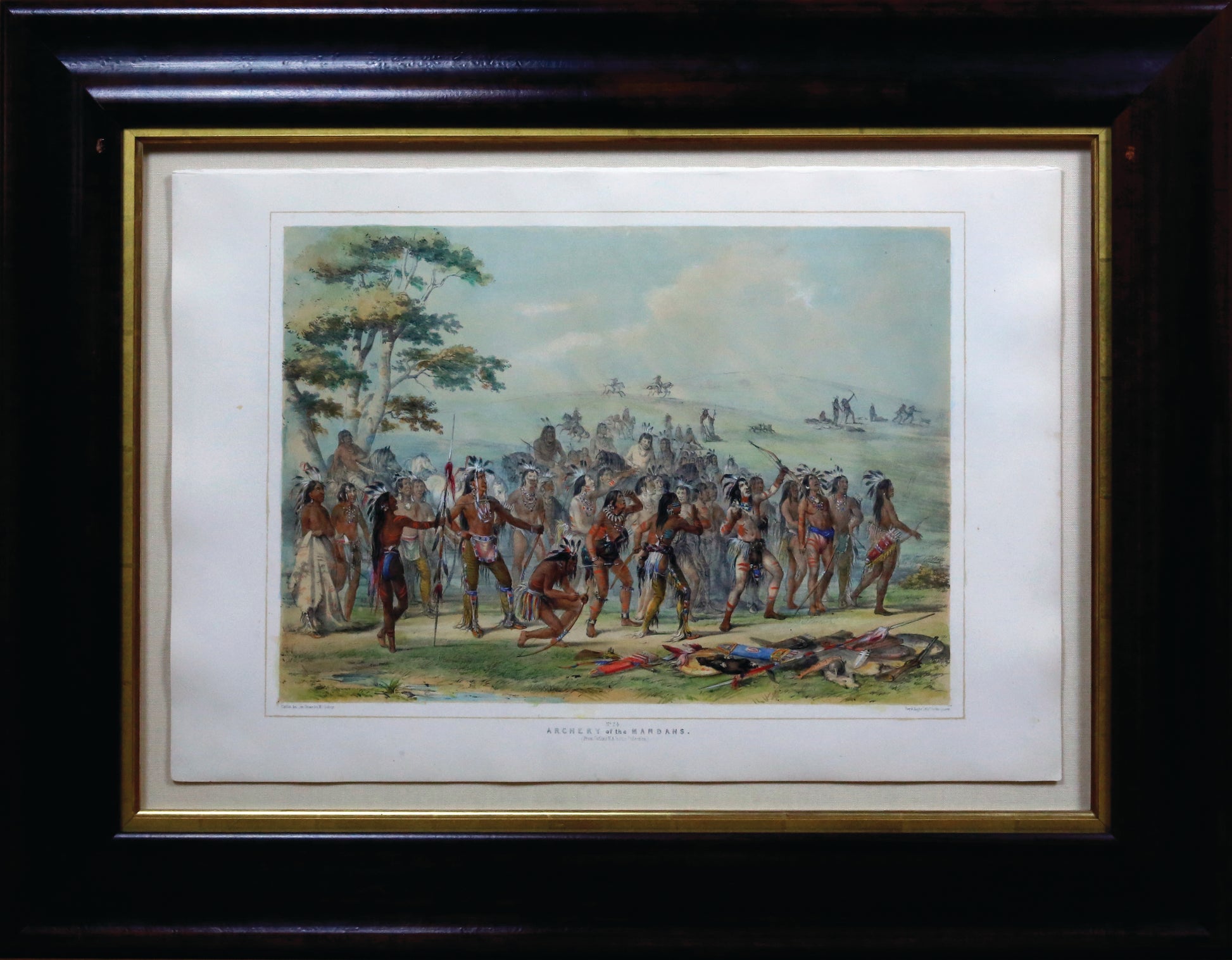from: Best of the West
CATLIN, George (1796-1872). North American Indian Portfolio. Hunting Scenes and Amusements of the Rocky Mountains and Praries of America. London: Geo. Catlin, Egyptian Hall, [1844].
CATLIN, George (1796-1872). North American Indian Portfolio. Hunting Scenes and Amusements of the Rocky Mountains and Praries of America. London: Geo. Catlin, Egyptian Hall, [1844].
Couldn't load pickup availability
CATLIN, George (1796-1872). North American Indian Portfolio. Hunting Scenes and Amusements of the Rocky Mountains and Prairies of America. London: Geo. Catlin, Egyptian Hall, [1844].
Folio. (23 4/8 x 18 inches). 25 EXCEPTIONALLY FINE lithographs on thick paper after drawings by Catlin, drawn on stone by Catlin and McGahey, printed by Day & Haghe and HAND-COLOURED. 19th-century half crimson morocco (waterstained).
THE FIRST IMAGES OF THE NATIVE AMERICAN TRIBES OF THE UPPER PLAINS
First edition. George Catlin was the first artist to travel widely among the Plains Indians of North America and create an important body of paintings and graphics to illustrate their customs and artifacts. His purpose was both unselfish and romantic. He wanted, and labored unceasingly, to persuade his contemporaries that Native American culture should be honored and preserved. During the 1830's, Catlin gathered artifacts and turned his sketches and recollections of the prairie into paintings. In 1827, George Catlin, an illustrator from Philadelphia, became the first artist to attempt the perilous journey up the Missouri River, and the first to create visual records of his experiences traveling among the Plains Indians of North America. The artist himself best expressed his goal in the preface to the first edition of his North American Indian Portfolio: "The history and customs of such a people, preserved by pictorial illustrations, are themes worthy the lifetime of one man, and nothing short of the loss of my life shall prevent me from visiting their country and becoming their historian." Over the next eight years, Catlin would travel extensively throughout the Western Plains of America doing just that, and accumulating his "Indian Gallery", which consisted of hundreds of oil paintings he executed presenting the appearances and customs of the 48 different tribes of Native Americans he encountered during his journey.
Catlin began to display his Indian Gallery in 1837, touring it in the United States for the next two years before taking the show to London. Having established a name for himself with the success of the Indian Gallery, Catlin turned his attention to finishing his first book, "The Manners, Customs, and Condition of the North American Indians…" which first appeared in the fall of 1841. This book was to become one of the most important works on American Indians published in the 19th century. Catlin's project filled a great need. After Lewis & Clark's celebrated expedition up the Missouri River into the Pacific Northwest, Europeans read avidly of the sights and experiences of the voyage. They traced the route followed by the explorers, using the map that accompanied the wildly popular printed volumes on the journey. But a crucial aspect was missing from the accounts of the expedition of Lewis and Clark. Without pictorial documentation, Europeans (and Americans) were unable to visualize the unbelievable journey. This lack meant that the people, landscape, and customs of the vast American frontier remained abstract ideas-and much less vividly imaginable-to anyone who had not personally experienced the voyage.
When Catlin first issued his portfolio, as here, in 1844, his animated, colorful, sympathetic views of Native Americans finally filled the void of imagery. Suddenly, Europeans and Americans were able to visualize the people and customs of whom they had read so extensively, and to gain a level of respect for the Native Americans, so often feared, misunderstood or misrepresented. The artist's stunning lithographs ranged from portraits to depictions of tribal ceremonies, from the anecdotal to the idealized. Catlin appealed to his readers with the thrill of the hunt and the mystery of ritual, and conveyed his respect for his subjects masterfully. The immediacy of his images is irresistible, drawing viewers into the scenes and portraits with unprecedented intimacy. But even when Catlin issued the North American Indian Portfolio, just fifteen years after his expedition, his crusade to preserve America's "Noble Savage" was failing. The Indians were beginning to give way to the expansion of the American frontier and to European disease. Because most of Catlin's paintings and collections were destroyed by fire and neglect, his lithographs remain the principal medium by which his message was conveyed, and they have come to hold even greater significance today than when they were first published. Reese issue 1.
![CATLIN, George (1796-1872). North American Indian Portfolio. Hunting Scenes and Amusements of the Rocky Mountains and Praries of America. London: Geo. Catlin, Egyptian Hall, [1844].](http://aradernyc.com/cdn/shop/files/Catlin_4_Framed.jpg?v=1684531283&width=1445)

